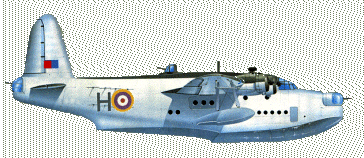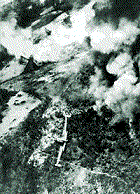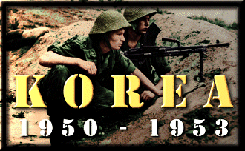The Air War

When North Korea invaded South Korea on 25th June 1950, the United Nations condemned the action and UN troops were ordered into action. The United Nations forces would be commanded by United States General MacArthur, with only limited air support the UN troops lost Seoul and were driven back into the extreme south of the country. However, the US Far East Air Force held the North Korean air force at bay until USN carriers arrived in Korean waters. Whereas the Royal Navy carriers and Fleet Air Arm were heavily involved in the air fighting and ground attack sorties, the RAF had no actual fighter forces in Korea.
Although RAF, RAAF and RCAF pilots flew with the USAF during the war, the RAF aircraft were mainly bombers, flying boats and transports. Although, RAF Sunderlands of No.205 Squadron had given air cover to United Nations naval forces bombarding Communist coastal towns in February. Aircraft of the Seletar Sunderland wing, made up of Nos 88, 205 and 209 Squadrons were based at Iwakuni in southern Japan on four-week deployments.
RAF pilots also served with No.77 Squadron RAAF, they joined the squadron when it re-equipped with Gloster Meteors from P-51 Mustangs and flew the first sorties from Kimpo on 30th July 1951. Two of the pilots were later lost. The MIG soon appeared and the Meteor was easily out-classed by this more powerful and more agile machine and was relegated to ground-attack missions.

No.77 Squadron flew its first Meteor ground attack sortie to Chongdan on 8th January, followed by no less than 1,773 sorties by the end of February, but lost two pilots in the process. Meanwhile the Sunderlands had continued to fly long maritime reconnaissance missions in all weathers alongside the US Navy PBM-5 Mariners also based at Iwakuni as part of Fleet Air Wing 6. Two other RAF units were now operating over Korea. Nos 1903 and 1913 Flights equipped with Auster AOP6, army co-operation aircraft, flying an average of 500 sorties a month spotting for UN artillery and flying reconnaissance missions, operating from primitive forward airstrips and spending as much as three hours flying over enemy positions. Although no fighter opposition was encountered, two Austers were lost to ground fire. The first MiG-15 fell to an RAF pilot when Flight Lieutenant John Nicholls completed 100 missions in six months with No.335 Fighter Interception Squadron USAF at Seoul, shooting down a MiG on his last but one mission in Korea in December 1952, having previously damaged three others. Other RAF pilots who flew with USAF units in Korea included:
Flight Lieutenant Lovell from No.43 Squadron.
Flight Lieutenant Daniel who flew with 334 FIS at Kimpo and was credited with damaging two MiGs during his six-month tour during 1952.
Wing Commander Johnnie Baldwin, Sabre was shot down in 1952 and he was posted missing.
Flight Lieutenant RTF Dickinson, shooting down One MiG-15
Flight Lieutenant John Granville-White, One MiG 15 kill
Flight Lieutenant Graham S Hulse, Three MiG 15 kills
As well as the RAF pilots, Lieutenant Peter Carmichael RN (802 Squadron, on HMS Ocean) who was given credit for shooting down a MiG-15 on the 9th of August 1952. He was in fact, one of four pilots who engaged and shot at the MiG but was given the credit as Flight leader. Several RCAF pilots also flew with the USAF and obtained kills in the F86 Sabre.
Along with the RAF pilots some RCAF Pilots were seconded to the 5th USAF among these were:
- Flight Lieutenant Ernest A Glover. (4th Fighter Interceptor Wing, 334th Squadron). 3 MiGs destroyed, two damaged
- Flight Lieutenant Claude JA LaFrance. (51st Fighter Interceptor Wing, 39th Squadron). One MiG shot down
- Squadron Leader JA Omer Levesque. (4th Fighter Interceptor Wing, 334th Squadron). One MiG 15 shot down
- Squadron Leader James D Lindsay (51st Fighter Interceptor Wing, 39th Squadron). Three MiG-15s damaged and Two Mig-15s shot down
- Squadron Leader John MacKay (51st Fighter Interceptor Wing, 39th Squadron). One MiG 15 shot down
- Flight Lieutenant Laurence E Spurr (51st Fighter Interceptor Wing, 25th Squadron). One MiG 15 shot down
- Flying Officer S Bruce Fleming (51st Fighter Interceptor Wing, 25th Squadron). One MiG 15 damaged
- Flying Officer Andrew Lambros (51st Fighter Interceptor Wing, 39th Squadron). Two MiG 15 damaged.
- Flight Lieutenant Grant H Nichols (51st Fighter Interceptor Wing, 16th Squadron). One MiG 15 damaged
When the ceasefire came into effect on 27th July 1953, the Auster flight had completed over 3,000 sorties with the loss of two pilots. the Sunderland wing flew 1,647 sorties, 205 Squadron having flown half a million miles during the war and losing only a No.88 Squadron aircraft which capsized following a heavy landing at Iwakuni. A second Sunderland from 205 squadron was lost on 28th January 1951 when it crashed at Mt. Yulion Taiwan while flying a mission from Iwakuni to support the UN forces in Korea. A memorial was later erected in Taiwan to the crew, an article regarding the memorial can be seen at the Taipei Times. Thanks to Derek marsh adn Simon Coy for the link and details of the second sunderland loss.
No.77 Squadron RAAF flew 18,872 Mustang and Meteor sorties, 77 Sqn started their war effort flying Mustangs from their base in Japan, moving to Korea later and then converting to the Meteor. The conversion was carried out under instruction by the first four RAF pilots. Some of the Australian losses happened in the Mustang period. All the six RAF pilots were lost flying Meteors. It is worthy of note that over 17,000 Australians served in Korea and 340 died there. The 77 Sqn Aussie losses were ten percent of those killed from less than 250 pilots. The six RAF losses were from the 23 pilots who flew a significant number of missions from the 29 RAF pilots who served with 77 Sqn, the rest arrived just as the war was ending. Seven pilots including one RAF became POWs and were treated barbarically. 77 Squadron was credited with the destruction of 3,700 buildings, 1,500 vehicles, 16 bridges and three MiG-15s.
Interdiction
From the very start of the Korean War, the Allied air forces went after the enemy's communications network and his logistics support for the armies. It was dangerous, flying at high speed and at low level into possible anti-aircraft traps, to smash the enemies transportation network. The interdiction work began in June 1950 and gained increasingly in effectiveness throughout the war. UN airpower was brought to bear as soon as a Communist offensive took shape and helped to smash the impetus.
The MiG-15 was the biggest problem of the early air war, the Russian built fighter was faster than the F80 Shooting Star and F9F Panther, easily outclassing them in maneuverability as it did the older WW2 era aircraft. Only the F86 Sabre proved its equal and was rushed across the Pacific. The heavy losses experienced by the Communists in the air were a combination of training accidents, crashes and shootings down, the USAF claim that 818 MiG-15s were destroyed in many battles high above the southern approaches of the Yalu river for the loss of 58 Sabres. There is doubt as to the accuracy of these figures.
The Manchurian border was officially inviolate, but Sabres were known to chase the enemy over the border. Anti-aircraft installations on the Chinese side of the river were not subjected to suppression by defence suppression aircraft. The geography of Korea forced road and rail traffic to the narrow east and broad west coast plains, as fast as the transportation links were destroyed, the enemy repaired and replaced them. The Communist troops needed less than a fifth of the supplies a US Soldier needed at the front, and half that of an ROK soldier. The North Koreans could make do with large numbers of peasants, mules, horses, camels and coolies to carry equipment to the frontline. Using the A-frame the ubiquitous peasant could move ammunitions, food and smallarms anywhere. They could not be countered by air power.
As well as the RAF and RAAF squadrons, RAF and RCAF pilots serving in the USAF, No.2 'Cheetah' squadron of the South African Air Force fought in Korea from November 1950 with P-51 Mustangs, converting to F-86 Sabres in January 1953.
The interdiction campaign had consumed massive amounts of effort from early 1951 to the end of 1952, almost 100% of the offensive effort of the carriers, 60% of USMC aircraft, 70% of the 5th USAF and 70% of the blockading effort of ships along the east coast was devoted to the interdiction of Communist supplies.
Cherokee
The Communists expended great effort getting supplies down to the peninsula, where the stores dumps were exposed near the front line and out of range of artillery. These were prime targets for surprise raids by naval aircraft, the Cherokee strikes. The first taking place on 9th October on a supply area 20 miles north of the Punchbowl, by Mid-October 50% of TF 77's attack potential was devoted to Cherokee strikes. Cherokee peaked in November and December of 1952 but dwindled in the bad weather although they continued successfully to the end of the war.
The final blows, and they were devastating, saw the Far East Air Force attacked Toksan dam on Potong River to the north of Pyongyang destroying five square miles of rice crops which were swept away and 700 buildings destroyed, Sunan airfield was under water, five miles for railway line and a two mile stretch of road was destroyed or damaged. Chosan dam was destroyed and the dam at Kyuwonga was severely damaged, depriving more rice fields of their water and causing severe suffering to the crop. These strikes did more damage than weeks of interdiction work.



